
In the FinTech industry, streamlining the onboarding process is key to helping customers understand and engage with the product. Identity verification is an indispensable factor in the FinTech onboarding process, and in this blog, let’s delve into why this is a critical step.
Challenges and Risks in the FinTech Industry
Identity theft is a significant threat in the FinTech industry. In 2022, credit card fraud for new accounts accounted for 43.7% of all identity theft types in the USA. Miscellaneous identity theft, including online shopping and payment account fraud, email and social media fraud, and other forms of identity theft, followed at 28.1%. States like Georgia, Louisiana, and Florida reported the highest number of identity theft cases.
To address these challenges, FinTech companies leverage advanced tools and technologies to streamline their onboarding processes. Solutions such as LexisNexis, Norkom Technologies, Comply Advantage, Accuity, WorldCheck, and DocumentChecker facilitate efficient onboarding.
Need for AML Verification During Customer Onboarding
The importance of AML verification during customer onboarding for FinTech companies cannot be overstated. Here are the key reasons why identity verification is essential:
Mitigation of fraud
Thorough identity verification helps mitigate fraudulent activities by ensuring that customers are who they claim to be, minimizing the risk of using stolen identities.
Regulatory compliance
Financial regulations necessitate identity verification to prevent money laundering, terrorist financing, and other financial crimes. It is a legal requirement for FinTech companies to verify the identity of customers before providing financial services.
Data safety and security
Protecting customers’ personal and financial data from unauthorised access or misuse is paramount in the FinTech industry. Identity verification safeguards this data, ensuring customer trust and maintaining data security.
Enhanced customer experience
Automated identity verification processes are useful in quickly verifying a customer’s identity and in speeding up the onboarding process, allowing customers to start using the services immediately.
Methods of Identity Verification in FinTech Onboarding
- Biometric verification involves using biometric data, such as fingerprints or facial recognition, to verify the customer’s identity.
- Knowledge-based authentication involves asking the customer to answer questions about themselves that are only known to them, such as their mother’s maiden name or their first pet’s name.
- Document verification refers to asking the customer to provide a copy of a government-issued ID, such as a passport or driver’s license, and comparing it to the customer to ensure that the ID belongs to the person applying.
- Social media verification includes using information from the customer’s social media profiles to verify their identity, such as their employment history or connections to other people.
Additionally, companies like Allsec adhere to regulatory-mandated KYC processes, including CDD, EDD, UBO identification, PEP screening, transaction review, and compliance team escalations, to ensure compliance and mitigate risks.
By implementing robust identity verification measures and staying vigilant against fraudulent activities, FinTech companies can create a secure environment for their customers and foster trust in their services.
In conclusion
By prioritizing a seamless signup and onboarding process, FinTech companies can build an engaged customer base, driving growth and success. Optimizing the onboarding process is crucial to comply with regulations, mitigate fraud, protect customer data, and enhance the overall customer experience.


